Difference between Active Buzzer and Passive Buzzer
Buzzers are divided into active buzzers and passive buzzers. The "source" here does not refer to the power supply, but the oscillation source. Active buzzers have oscillation sources, while passive buzzers do not. The differences between them also include: different working principles, different appearances, different prices, different test sounds and multimeter resistance measurements, different requirements for input signals, different DC voltage tests, and different applicable scenarios. Next, ATO Automation Store will elaborate in detail for you.
Different Working Principles
From the working principle point of view, the active buzzer has an internal oscillation source. It only needs to be connected to a DC power of rated voltage to emit a sound of a specified frequency. The frequency is determined by the internal oscillation circuit and cannot be changed. It is powered by DC voltage and is an integrated electronic sounder.
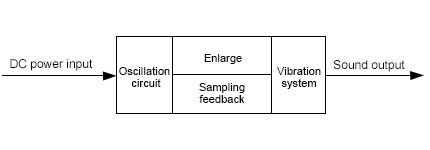
The passive buzzer uses the electromagnetic induction phenomenon. After the voice coil is connected to the alternating current, the electromagnet formed and the permanent magnet attract or repel each other to push the diaphragm to make a sound. When connected to DC power, it can only continuously push the diaphragm but cannot produce sound. It can only produce sound when it is connected or disconnected.
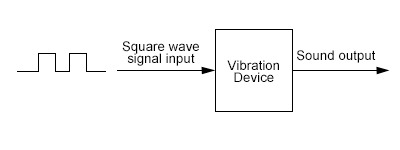
Different Appearances
The pins of both buzzers are placed upward, it can be seen that the one with a green circuit board is a passive buzzer, and the one without a circuit board and sealed with black glue is an active buzzer. The height of the active buzzer is 9mm, while the height of the passive buzzer is 8mm.
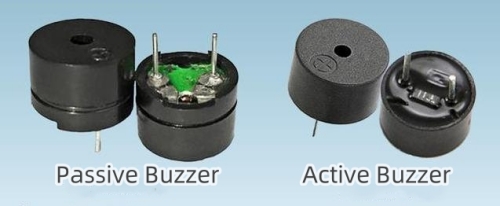
Different Prices
Passive buzzers are usually cheaper than active buzzers because passive buzzers do not have internal oscillators and control circuits.
Different Testing Sound and Measuring Resistance with a Multimeter
Using multimeter the black test lead to the "+" pin of the buzzer, and touch the other pin back and forth with the red test lead. If it triggers a clicking sound and the resistance is only 8Ω, it is a passive buzzer. If it can make a continuous sound and the resistance is more than several hundred ohms, it is an active buzzer.
Different Drive Circuits
The main difference between the driving circuit of active buzzer and passive buzzer is that the passive buzzer is essentially an inductive element, and its current cannot change transiently, so a freewheeling diode must be provided to provide freewheeling. Otherwise, there will be a reverse induced electromotive force at both ends of the buzzer, generating a spike voltage of tens of volts, which may damage the driving transistor and interfere with other parts of the entire circuit system. If the operating voltage in the circuit is large, a diode with a larger withstand voltage value should be used, and if the circuit operating frequency is high, a high-speed diode should be selected.The role of the 4K7 resistor in the figure: current limiting resistor to prevent excessive base current from damaging the diode. The role of the 10K resistor: pull-down resistor to prevent the buzzer from accidentally working due to interference signals.
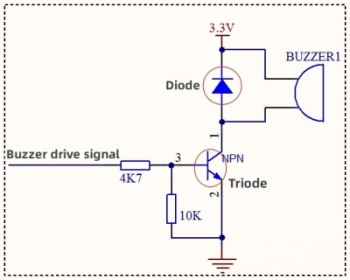
Different Requirements for Input Signals
The ideal signal for active buzzer operation is direct current, usually labeled VDC, VDD, etc. Because there is a simple oscillation circuit inside the buzzer, it can convert constant direct current into a pulse signal of a certain frequency, and then produce an alternating magnetic field to drive the molybdenum plate to vibrate and sound. However, some active buzzers can also work under specific AC signals, but the voltage and frequency of the AC signal are very high, so this working method is generally not used. Passive buzzers do not have internal drive circuits. Some companies and factories call them buzzers, but they are called sounders in the national standard. The ideal signal for passive buzzer operation is a square wave. If a pre-DC signal is given, the buzzer will not respond because the magnetic circuit is constant and the molybdenum plate cannot vibrate and sound.
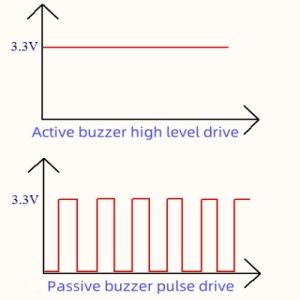
Different DC Voltage Test
Generally, the general voltage of 12MM passive is 1.5V, and the general voltage of active buzzer is 1.5, 3.0, 5.0, 9.0, 12V. Use DC voltage to input the corresponding voltage (can be adjusted from small to large), and the frequency is about 2.7KHz. As shown in the figure, when a low level is given to the driving signal pin, the buzzer will sound directly. The passive buzzer does not have an oscillation source inside. To make it sound, it must be driven by a pulse frequency signal between 500Hz and 4.5KHz. The active buzzer is also easy to drive and can be driven by the level. Because there is a definite correspondence between the scale and the frequency, the sound frequency of the passive buzzer can be controlled through oscilloscopes to produce the effect of "do re mi fa sol la si", and it can also produce simple music tracks, such as the birthday song.
Different Application Scenarios
The active buzzer has a large volume, good sound quality, and adjustable tone. It is suitable for scenes that require high sound quality and large volume. For example, electronic keyboards, recording studios, concerts and other high-end audio equipment and places. Passive buzzers are simple in structure, easy to use, and cheap, making them ideal for many application scenarios. For example, alarms, doorbells, timers, gaming devices.
Summarize
Active buzzers and passive buzzers are common buzzer types, and there are certain differences in working principle, appearance, price, drive circuit, etc. When purchasing or using, you can judge by looking at the logo and conducting a power connection test. In actual application, it is necessary to select the appropriate type according to the needs, and carry out drive circuit design and parameter adjustment to obtain a sound prompt effect that meets the requirements.

